Analysis on the Seismic Performance of Steel Fiber-Reinforced High-Strength Concrete Beam–Column Joints
Abstract
:1. Introduction
2. Finite Element (FE) Modeling
2.1. Material Model
2.1.1. λ λ Concrete
2.1.2. λ λ Steel
2.2. FE Models and Boundary Conditions
2.3. Verifications of the FE Modeling
2.3.1. λ λ Load vs. Displacement Hysteresis Curves and Peak Load
2.3.2. λ λ Failure Modes
3. Seismic Behavior Analysis and Discussion
3.1. Complete Curves Analysis
3.2. Failure Analysis of Specimen BCJ1
4. Parametric Study
4.1. Effect of Concrete Strength
4.2. Effect of the Steel Fiber Volume Ratio
4.3. Effect of Stirrup Ratio in the Joint Area
5. Conclusions
- The reasonable agreement between experimental and corresponding FE results is achieved generally, and therefore, the FE modeling approach can be adopted to further investigate the seismic behavior of SFRHC–BCJs.
- Based on the predicted load vs. displacement hysteresis curves, the specimens are considered to experience three stages during the loading process: elastic stage, elastic–plastic stage, and failure stage. In addition, the failure modes and processes were analyzed and clarified in detail, including the beam-end bending failure (BFF) and joint shear failure (JSF) in the core area.
- Based on the stress nephogram, the development of the stress distribution in the concrete and reinforcement during the loading process was clarified comprehensively.
- Increasing the concrete strength can slightly improve the ultimate load of BCJs, while the ductility decreased noticeably. Additionally, adding the steel fiber into concrete can clearly improve the seismic performance of the structure. Moreover, increasing the stirrup ratio in the core area can effectively improve the seismic performance of BCJs, and change the failure mode of BCJs.
Author Contributions
Funding
Institutional Review Board Statement
Informed Consent Statement
Data Availability Statement
Acknowledgments
Conflicts of Interest
Nomenclature
| SFRHC | Steel fiber-reinforced high-strength concrete |
| BCJs | Beam–column joints |
| FE | Finite element |
| BFF | Beam-end bending failure |
| JSF | Joint shear failure |
| FRC | Fiber-reinforced concrete |
| CDP | Concrete damaged plasticity |
| DCM | Discrete crack model |
| SCM | Smeared crack model |
References
- Ehsani, M.R.; Wight, J.K. Exterior Reinforced Concrete Beam–Column Connections Subjected to Earthquake Type Loading. J. Am. Concr. Inst. 1985, 82, 492–499. [Google Scholar]
- Tsonos, A.; Tsonos, A.G.; Penelis, G.G. Seismic Resistance of Type 2 Exterior Beam–Column Joints Reinforced with Inclined Bars. ACI Struct. J. 1992, 89, 3–12. [Google Scholar]
- Tsonos, A.G. Cyclic load behaviour of reinforced concrete beam–column subassemblages designed according to modern codes. Eur. Earthq. Eng. 2006, 20, 3–21. [Google Scholar]
- Tsonos, A.G. Cyclic Load Behavior of Reinforced Concrete Beam–Column Subassemblages of Modern Structures. ACI Struct. J. 2007, 104, 468–478. [Google Scholar]
- Kotsovou, G.; Mouzakis, H. Seismic behaviour of RC external joints. Mag. Concr. Res. 2011, 63, 247–264. [Google Scholar] [CrossRef]
- Kotsovou, G.; Mouzakis, H. Seismic design of RC external beam–column joints. Bull. Earthq. Eng. 2012, 10, 645–677. [Google Scholar] [CrossRef]
- EN1992–1 Eurocode 2. Design of concrete structures—Part 1–1. In General Rules and Rules for Buildings; European Committee for Standardization: Brussels, Belgium, 2004. [Google Scholar]
- EN 1998–1 Eurocode 8. Design of structures for earthquake resistance—Part 1. In General Rules, Seismic Actions and Rules for Buildings; European Committee for Standardization: Brussels, Belgium, 2004. [Google Scholar]
- Amato, G.; Campione, G.; Cavaleri, L.; Minafo, G. Flexural behaviour of external R/C steel fibre reinforced beam–column joints. Europ. J. Env. Civ. Eng. 2011, 15, 1253–1276. [Google Scholar] [CrossRef]
- Kabir, M.R.; Alam, M.S.; Said, A.M.; Ayad, A. Performance of hybrid reinforced concrete beam column joint: A critical review. Fibers 2016, 4, 13. [Google Scholar] [CrossRef] [Green Version]
- Abbas, A.A.; Mohsin, S.M.S.; Cotsovos, D.M. Seismic response of steel fiber reinforced concrete beam–column joints. Eng. Struct. 2014, 59, 261–283. [Google Scholar] [CrossRef] [Green Version]
- Issa, M.S.; Metwally, I.M.; Elzeiny, S.M. Influence of fibers on flexural behavior and ductility of concrete beams reinforced with GFRP rebars. Eng. Struct. 2011, 33, 1754–1763. [Google Scholar] [CrossRef]
- Zhu, H.; Li, Z.; Wen, C.; Cheng, S.; Wei, Y. Prediction model for the flexural strength of steel fiber reinforced concrete beams with fiber–reinforced polymer bars under repeated loading. Compos Struct 2020, 250, 112609. [Google Scholar] [CrossRef]
- Hammad, N.; El–Nemr, A.; Hasan, E.D. The performance of fiber GGBS based alkali–activated concrete. J. Build. Eng. 2021, 42, 102464. [Google Scholar] [CrossRef]
- Horňáková, M.; Lehner, P. Relationship of Surface and Bulk Resistivity in the Case of Mechanically Damaged Fibre Reinforced Red Ceramic Waste Aggregate Concrete. Materials 2020, 13, 5501. [Google Scholar] [CrossRef]
- Henager, C.H. Steel fibrous–ductile concrete joint for seismic–resistant structures. Spec. Publ. 1977, 53, 371–386. [Google Scholar]
- Filiatrault, A.; Pineau, S.; Houde, J. Seismic behavior of steel–fiber reinforced concrete interior beam–column joints. Struct. J. 1995, 92, 543–552. [Google Scholar]
- Shannag, M.J.; Abu-Dyya, N.; Abu-Farsakh, G. Lateral load response of high–performance fiber re–inforced concrete beam–column joints. Constr. Build. Mater. 2005, 19, 500–508. [Google Scholar] [CrossRef]
- Ganesa, N.; Indira, P.V.; Abraham, R. Steel fibre reinforced high performance concrete beam–column joints subjected to cyclic loading. ISET J. Earthq. Technol. 2007, 44, 445–456. [Google Scholar]
- Li, Y.; Aoude, H. Influence of steel fibers on the static and blast response of beams built with high–strength concrete and high–strength reinforcement. Eng. Struct. 2020, 221, 111031. [Google Scholar] [CrossRef]
- Gencoglu, M. The effects of stirrups and the extents of regions used SFRC in exterior beam–column joints. Struct. Eng. Mech. 2007, 27, 223–241. [Google Scholar] [CrossRef]
- Hawileh, R.A.; Rahman, A.; Tabatabai, H. Nonlinear finite element analysis and modeling of a precast hybrid beam–column connection subjected to cyclic loads. Appl. Math. Model. 2010, 34, 2562–2583. [Google Scholar] [CrossRef]
- Bui, Q.B.; Sentosa, B.; Duong, T.H. A Numerical Modeling of RC Beam–Column Joints Compared to Experimental Results. In Congrès International De Géotechnique–Ouvrages–Structures; Springer: Singapore, 2017. [Google Scholar]
- Jba, B.; Lh, A.; Yun, Z.A.; Hq, A. Modified the smeared crack constitutive model of fiber reinforced concrete under uniaxial loading. Constr. Build. Mater. 2020, 250, 118916. [Google Scholar]
- Shi, K.; Zhang, M.; Zhang, T.; Li, P.; Zhu, J.; Li, L. Seismic Performance of Steel Fiber Reinforced High–Strength Concrete Beam–Column Joints. Materials 2021, 14, 3235. [Google Scholar] [CrossRef] [PubMed]
- Zhang, Y.; Xilin, L.U.; Xuecheng, N. Stress–strain Behavior for High–strength Steel Fiber Reinforced Concrete under Tensile Loading. Eng. Struct. 2017, 33, 107–113. [Google Scholar]
- Lu, X.L.; Zhang, Y.; Nian, X.C. Experimental study on stress–strain curves for high–strength steel fiber reinforced concrete under monotonic and repeated compressive loadings. J. Build. Struct. 2017, 38, 135–143. [Google Scholar]
- Dassault Systèmes. Manual Abaqus 6.14; Dassault Systèmes: Velizy-Villacoublay, France, 2014. [Google Scholar]
- Wong, H.; Leo, C.J. A simple elastoplastic hardening constitutive model for EPS geofoam. Geotext. Geomembr. 2006, 24, 299–310. [Google Scholar] [CrossRef]
- Yan, J.; Zhang, W. Numerical analysis on steel–concrete–steel sandwich plates by damage plasticity model: From materials to structures. Constr. Build. Mater. 2017, 149, 801–815. [Google Scholar] [CrossRef]
- Ad, A.; Arm, B.; Faa, C. Evaluation of the efficacy of using engineered cementitious composites in RC beam–column joints. Structures 2020, 27, 151–162. [Google Scholar]
- Zhang, Q.; Liu, Y.; Bao, Y.; Jia, D.; Bu, Y.; Li, Q. Fatigue performance of orthotropic steel–concrete composite deck with large–size longitudinal U–shaped ribs. Eng. Struct. 2017, 150, 864–874. [Google Scholar] [CrossRef]
- Lee, S.H.; Abolmaali, A.; Shin, K.J.; Lee, H.D. ABAQUS modeling for post–tensioned concrete beams. J. Build. Eng. 2020, 30, 101273. [Google Scholar] [CrossRef]
- Jiuru, T.; Chaobin, H.; Kaijian, Y.; Yongcheng, Y. Seismic behavior and shear strength of framed joint using steel–fiber reinforced concrete. J. Struct. Eng. 1992, 118, 341–358. [Google Scholar] [CrossRef]
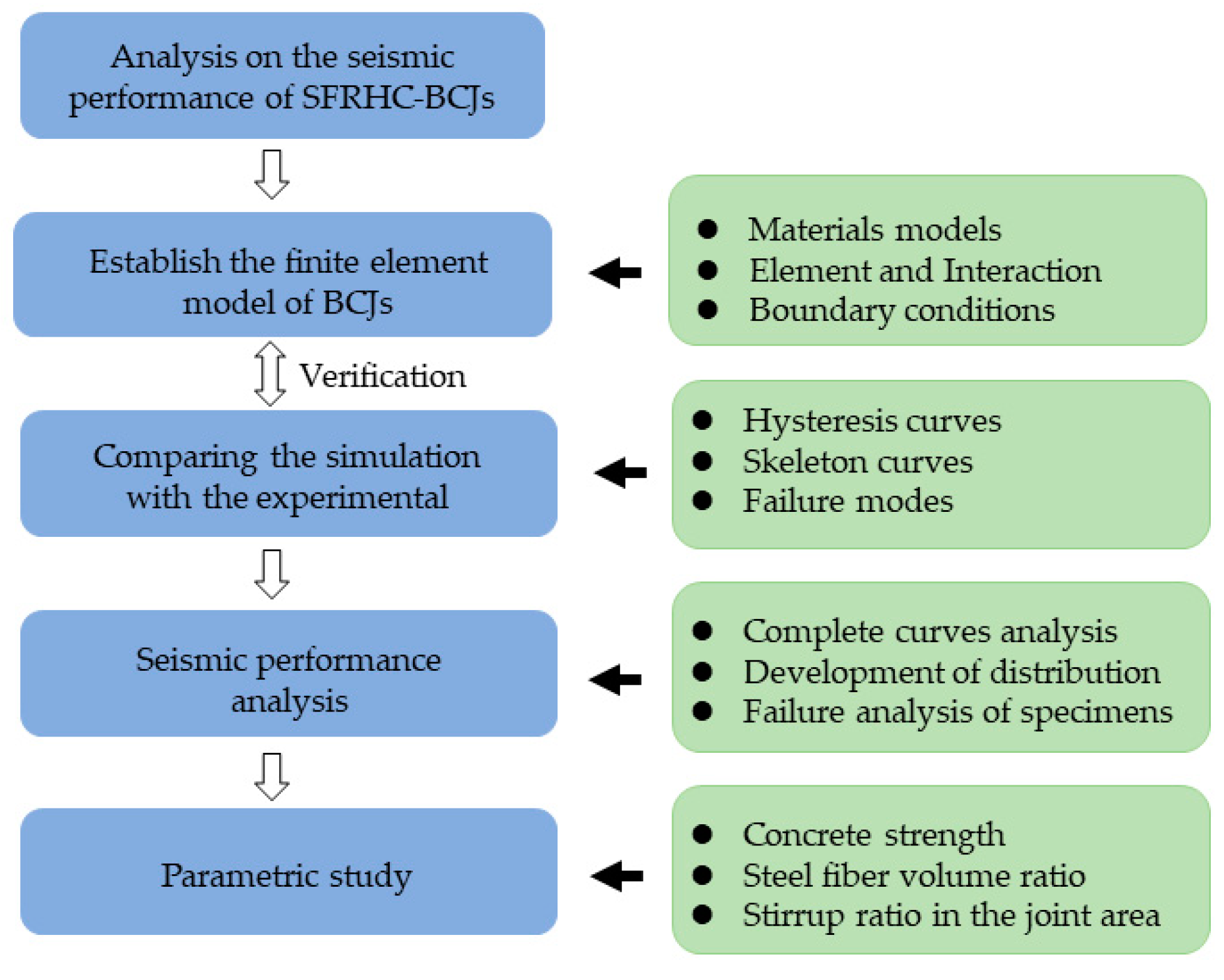

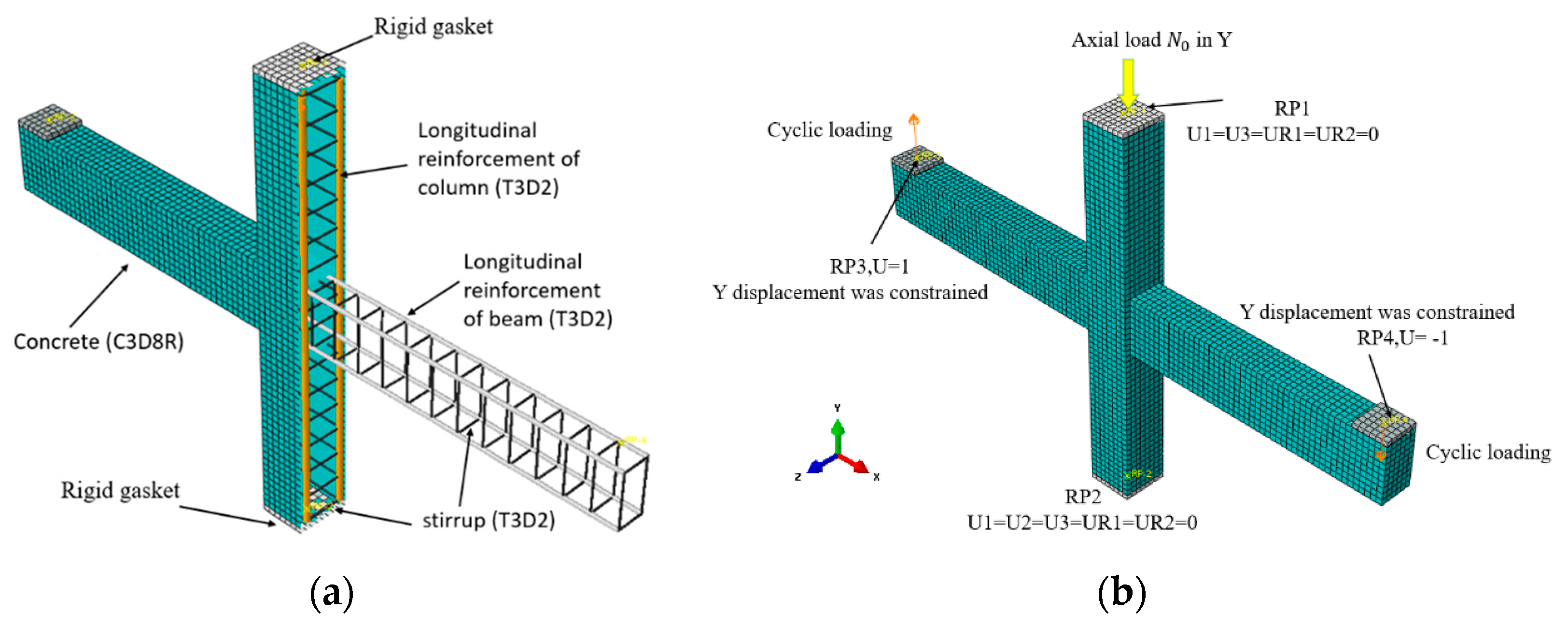

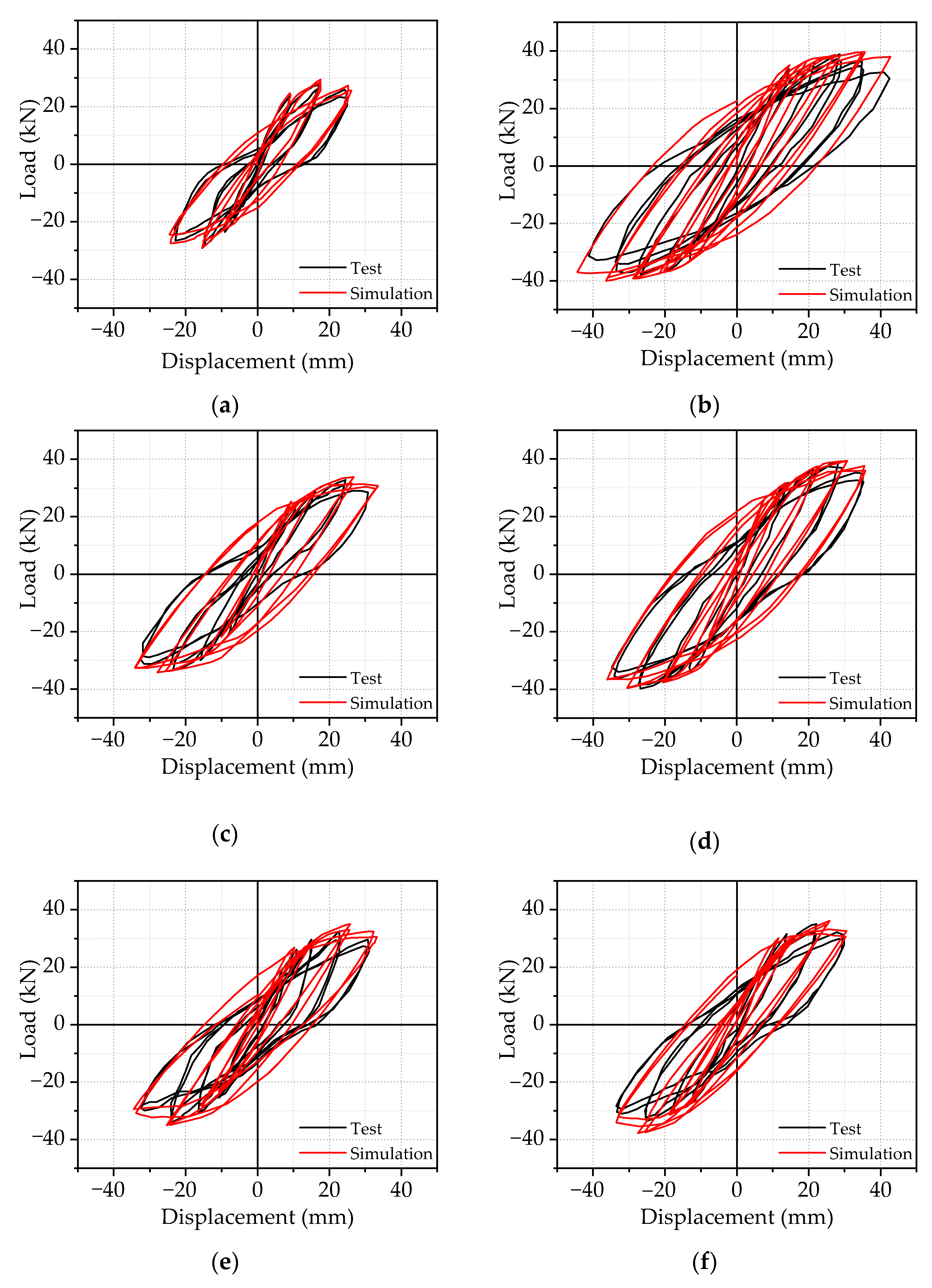
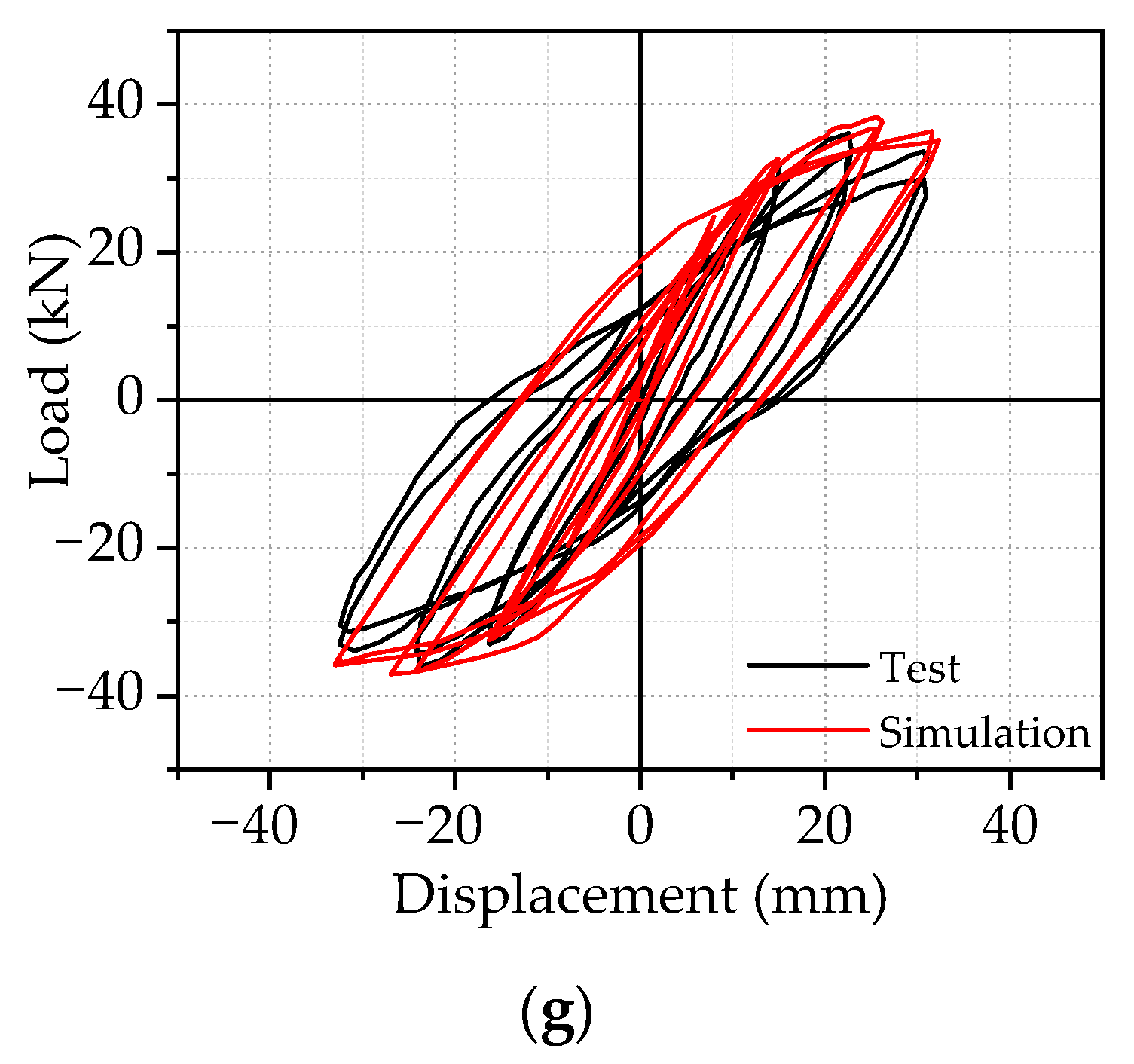
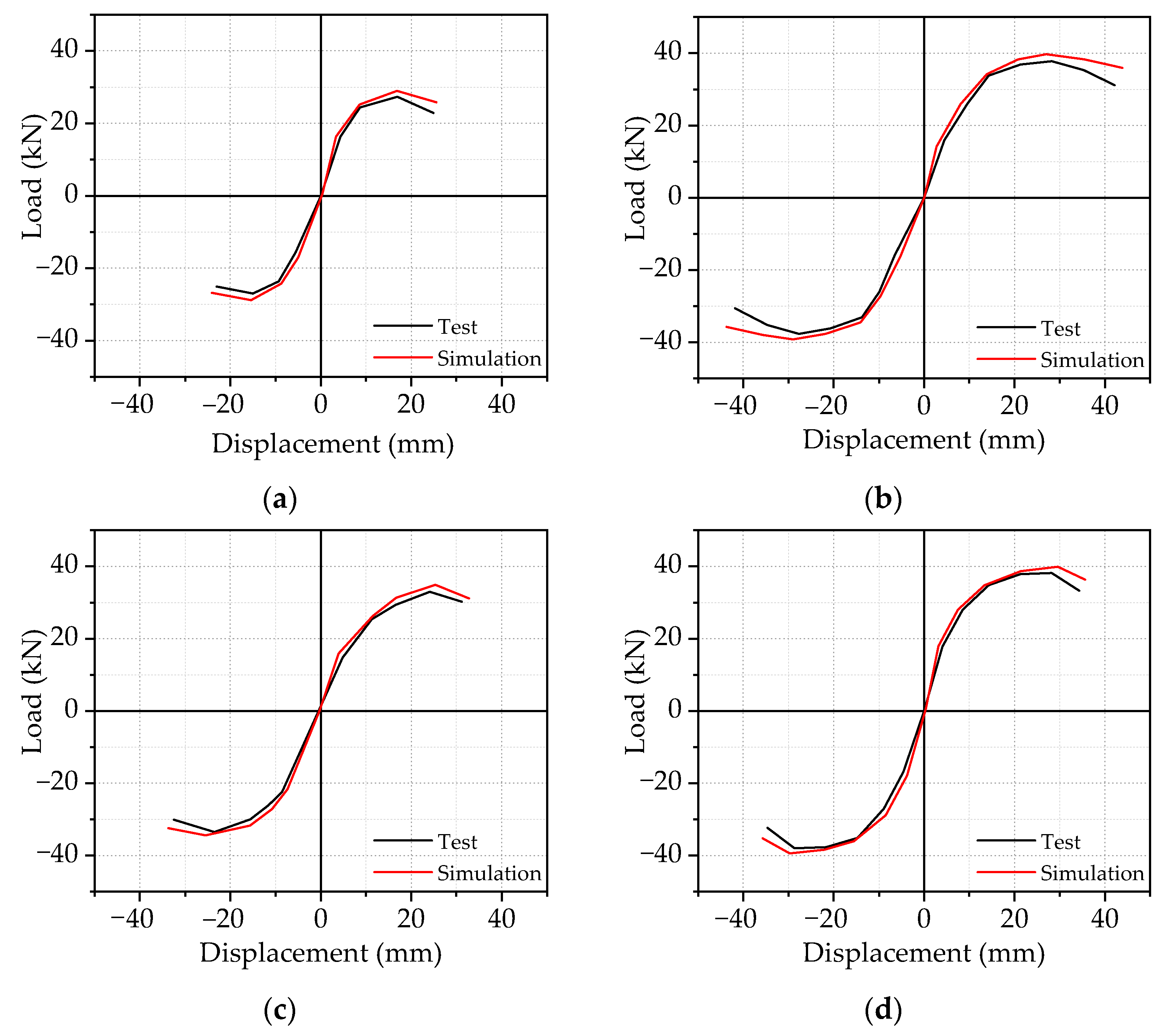
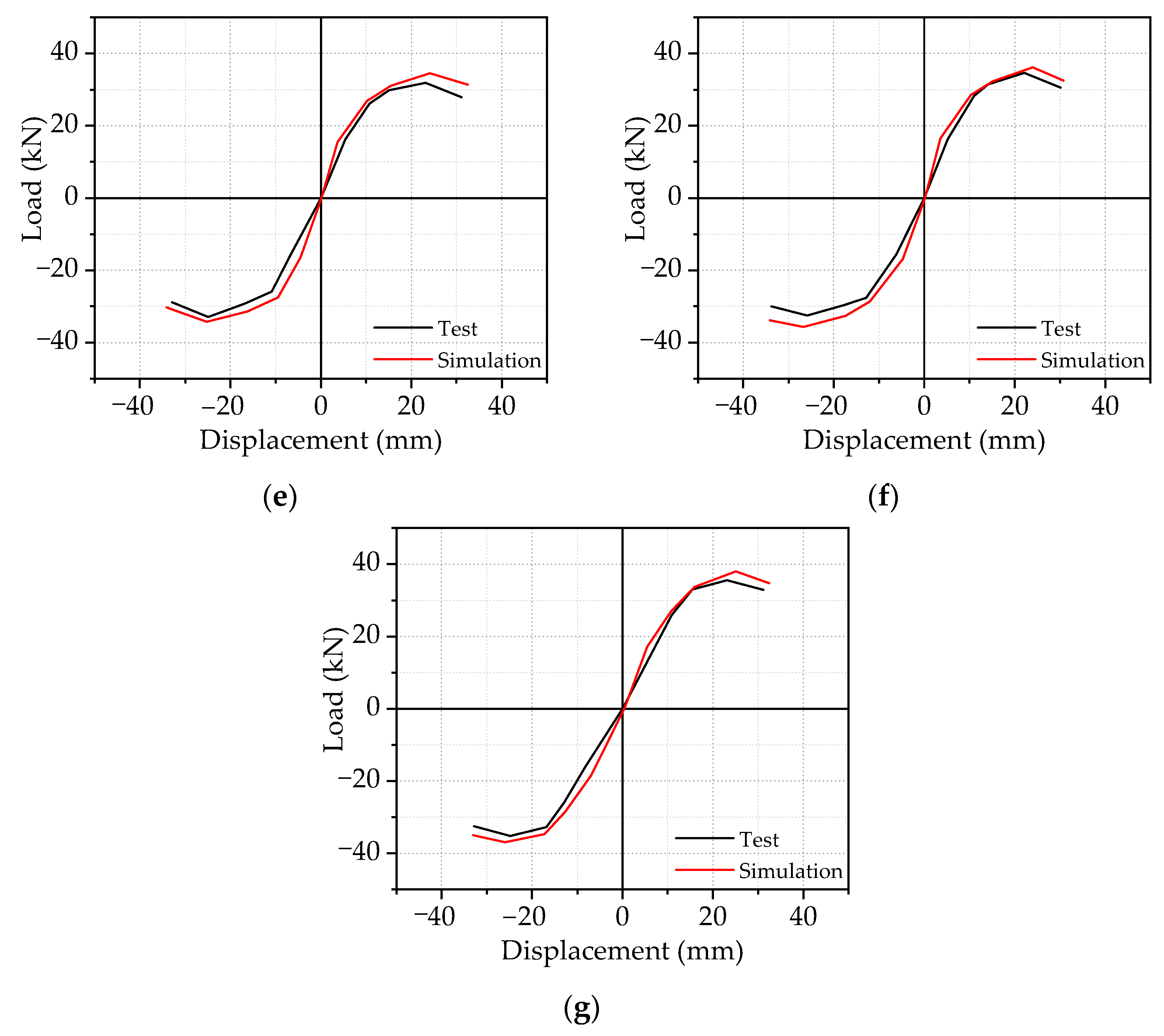


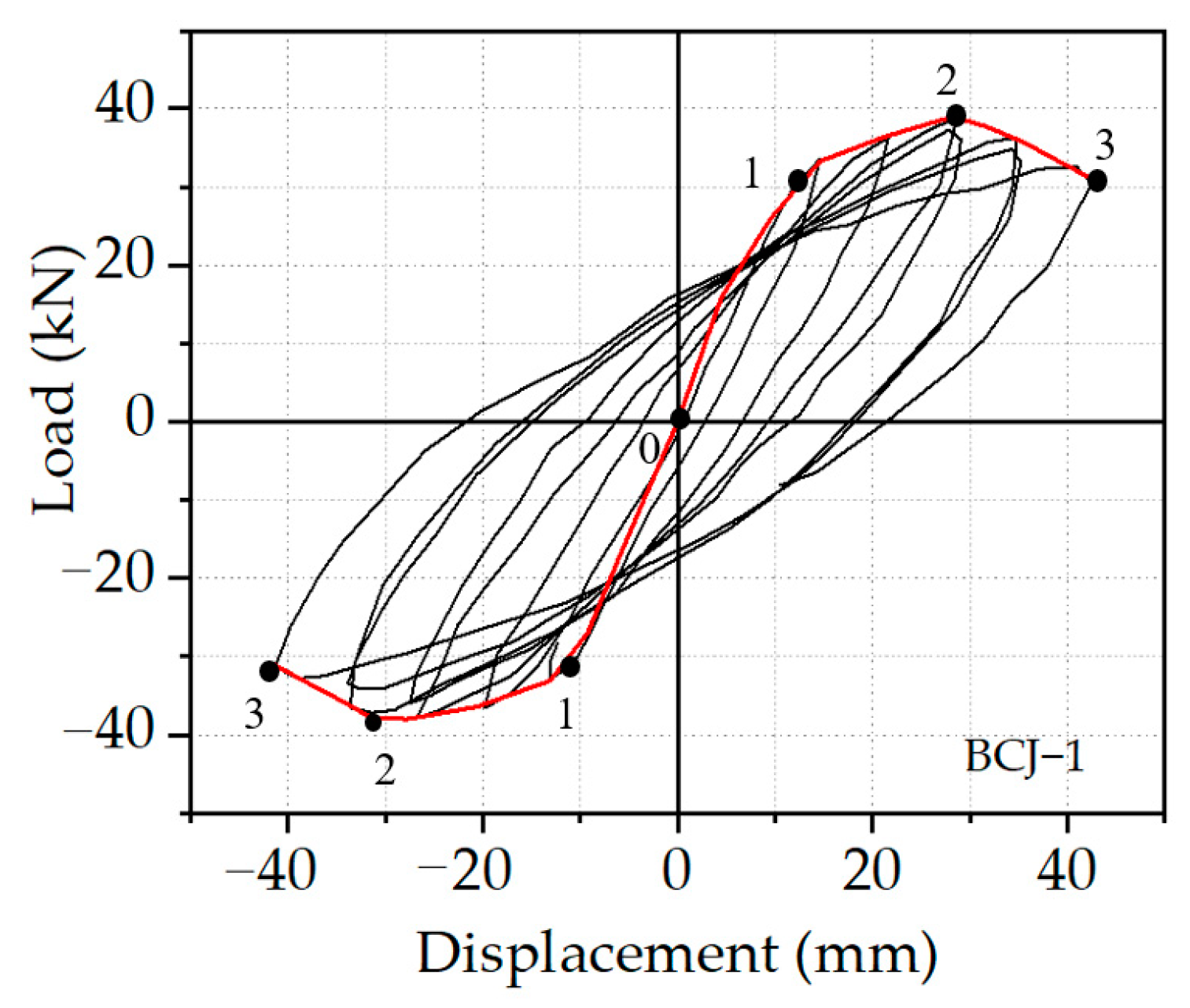

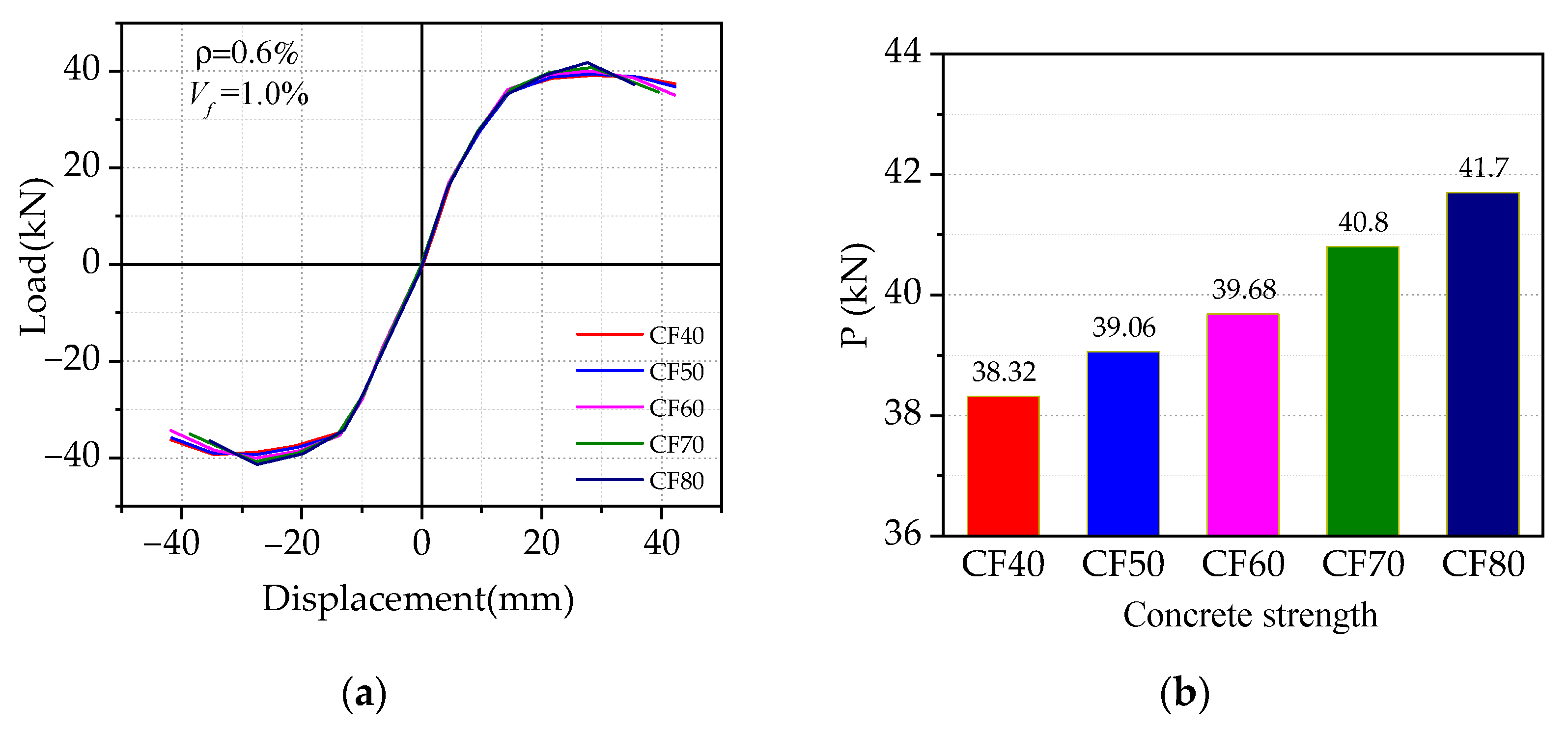

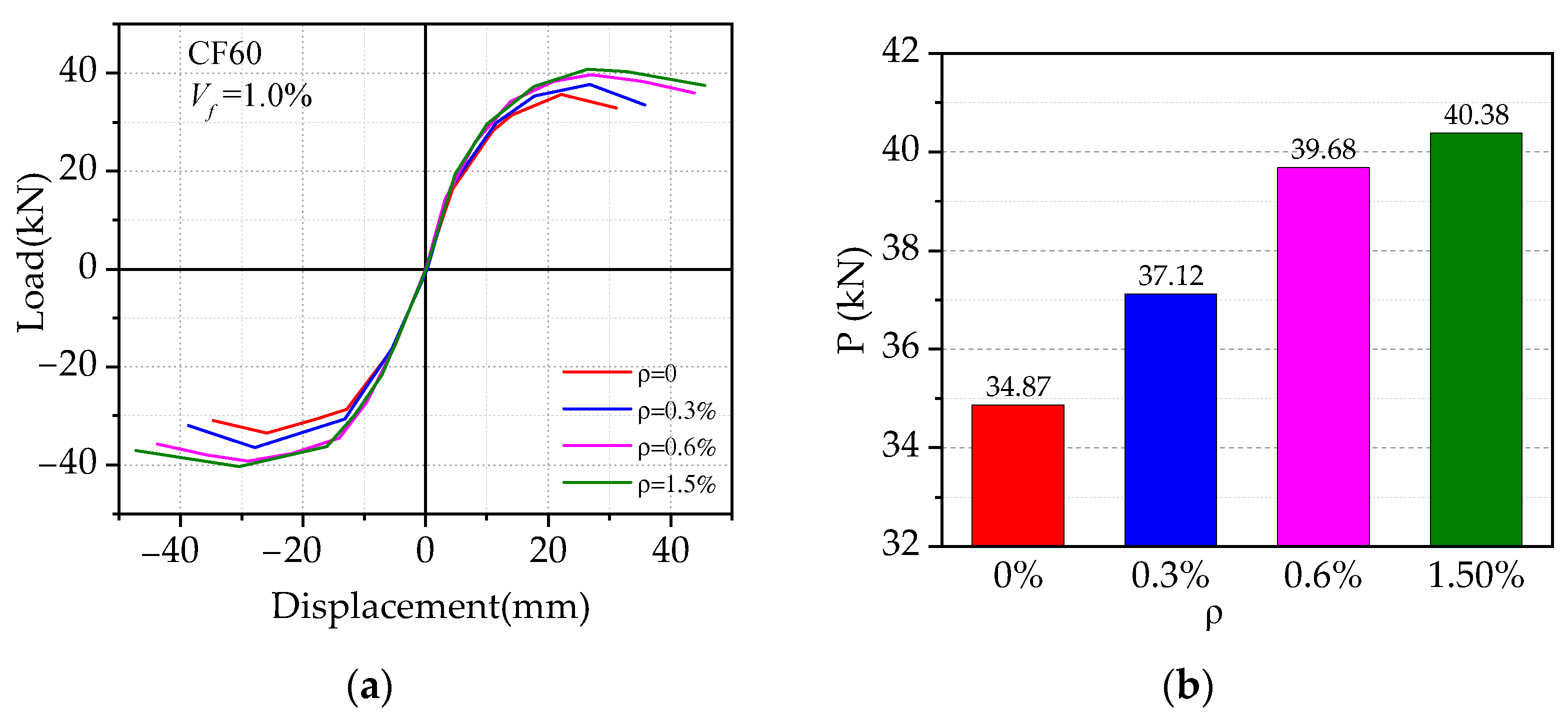
| Component Number | Py/kN | Pm/kN | Pu/kN | ||||||
|---|---|---|---|---|---|---|---|---|---|
| S | T | S/T | S | T | S/T | S | T | S/T | |
| BCJ0 | 24.32 | 23.34 | 1.042 | 29.13 | 27.35 | 1.065 | 24.76 | 22.02 | 1.124 |
| BCJ1 | 27.34 | 28.36 | 0.964 | 39.68 | 37.19 | 1.067 | 35.10 | 31.22 | 1.124 |
| BCJ2 | 27.32 | 26.73 | 1.022 | 34.68 | 33.25 | 1.043 | 30.20 | 27.43 | 1.101 |
| BCJ3 | 29.68 | 29.81 | 0.996 | 39.72 | 37.91 | 1.048 | 33.76 | 32.39 | 1.042 |
| BCJ4 | 27.94 | 26.49 | 1.055 | 34.33 | 32.51 | 1.056 | 29.18 | 27.68 | 1.054 |
| BCJ5 | 27.02 | 26.87 | 1.006 | 36.97 | 33.58 | 1.101 | 31.42 | 29.53 | 1.064 |
| BCJ6 | 28.15 | 27.92 | 1.008 | 38.28 | 35.42 | 1.081 | 32.54 | 29.8 | 1.092 |
| RE | 0.013 | 0.066 | 0.086 | ||||||
| COV | 0.028 | 0.018 | 0.029 | ||||||
Publisher’s Note: MDPI stays neutral with regard to jurisdictional claims in published maps and institutional affiliations. |
© 2021 by the authors. Licensee MDPI, Basel, Switzerland. This article is an open access article distributed under the terms and conditions of the Creative Commons Attribution (CC BY) license (https://creativecommons.org/licenses/by/4.0/).
Share and Cite
Shi, K.; Zhang, M.; Zhang, T.; Xue, R.; Li, P. Analysis on the Seismic Performance of Steel Fiber-Reinforced High-Strength Concrete Beam–Column Joints. Materials 2021, 14, 4016. https://doi.org/10.3390/ma14144016
Shi K, Zhang M, Zhang T, Xue R, Li P. Analysis on the Seismic Performance of Steel Fiber-Reinforced High-Strength Concrete Beam–Column Joints. Materials. 2021; 14(14):4016. https://doi.org/10.3390/ma14144016
Chicago/Turabian StyleShi, Ke, Mengyue Zhang, Tao Zhang, Ru Xue, and Pengfei Li. 2021. "Analysis on the Seismic Performance of Steel Fiber-Reinforced High-Strength Concrete Beam–Column Joints" Materials 14, no. 14: 4016. https://doi.org/10.3390/ma14144016
APA StyleShi, K., Zhang, M., Zhang, T., Xue, R., & Li, P. (2021). Analysis on the Seismic Performance of Steel Fiber-Reinforced High-Strength Concrete Beam–Column Joints. Materials, 14(14), 4016. https://doi.org/10.3390/ma14144016






